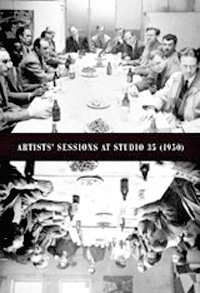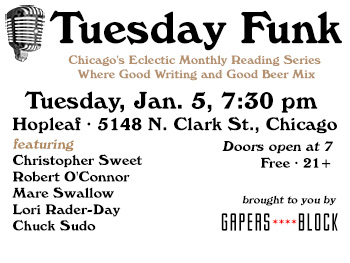| « Book Review: Liliane's Balcony: A Novella of Fallingwater by Kelcey Parker | Bookmarks » |
Interview Fri Dec 20 2013
Soberscove Press Q&A: A Conversation with Julia Klein
By Stuart Ross
Operated by Ukrainian Village resident Julia Klein, and with strong ties to Chicago artists and educators, Soberscove Press has been bringing new and overlooked documents to the general public and academic audiences since 2009. From transcripts that elucidate the beginnings of Abstract Expressionism, to the performative happenings of the Soviet-era avant-garde group Collective Actions, Soberscove fills a much needed gap in art publishing, shaping how we think about recent art history.
In addition to being responsible for every aspect of the press, Klein is an artist in her own right, whose work investigates how objects and materials persist over time. In 2013, she was an artist-in-residence at the Museum of Contemporary Art Detroit; a researcher in the Art Library at Sitterwerk in St. Gallen, Switzerland; and a fellow in the Terra Foundation Summer Residency in Giverny. She also teaches under-served Chicago youth at the Marwen Foundation.
I caught up with Klein to discuss the origins of the press, the role of publishing in constructing history, and what's in store next year.
What does the name of the press mean? What gave you the idea to start a press and what were your original goals?
The name was born in 2008, during my last summer in the MFA program at Bard College. One of my best friends there, the poet Biswamit Dwibedy, jokingly referred to our dorm, Obreshkove, as Soberscove. The name hit the note I was looking for: familiar yet unfamiliar, evocative yet also benign. I feel like it has a kind of casual authority.
 Soberscove's first book was Artists' Sessions at Studio 35 (1950). I came across the material while working for publisher George Braziller in New York. Having just graduated from art school, I read it and wondered why I never saw it before — I mean, here was this totally accessible discussion that captures so many famous artists talking about the basic issues of art-making. Like how do you know when a work is finished, or how do you title a work — eternal questions like these. I couldn't understand why it never came up during art history courses or in compilations of art history writings. So I just kept thinking and thinking about it, and finally started doing some research, and then took a very long series of baby steps toward publishing the book.
Soberscove's first book was Artists' Sessions at Studio 35 (1950). I came across the material while working for publisher George Braziller in New York. Having just graduated from art school, I read it and wondered why I never saw it before — I mean, here was this totally accessible discussion that captures so many famous artists talking about the basic issues of art-making. Like how do you know when a work is finished, or how do you title a work — eternal questions like these. I couldn't understand why it never came up during art history courses or in compilations of art history writings. So I just kept thinking and thinking about it, and finally started doing some research, and then took a very long series of baby steps toward publishing the book.
At first, my goal with the press was just as a vehicle to publish Artists' Sessions. Because I felt strongly about sharing it, and also because I wanted to prove to myself that I could follow though with an idea I couldn't stop thinking about. I didn't have any grand vision, other than imagining there was similar material I might want to share. And in fact, during the project, I found the material for The Waldorf Panels on Sculpture (1965), which I would publish in 2011.
Publishing a book like Artists' Sessions probably sets the tone right off and fits your mission statement to publish books that fill a gap in the literature.
That's the thing about Artists' Sessions. It's referenced all the time but before it came out in the Soberscove edition it wasn't easy to find if you weren't a specialist. The discussions are a really accessible introduction to the time period as well as to still-relevant ideas about contemporary art. I felt we were doing something important by making it available at a relatively inexpensive price.
More selfishly, at some point I realized the people I was having the majority of conversations with about art were the artists in these transcripts. Meaning I wasn't really having conversations after all! So I hoped that by publishing the transcripts, it would make it easier to connect with other contemporary artists who shared my interests. The book could be a common touchstone.
With Soberscove, I am able to push forward what I want. It's a way to play a role in constructing history, either by resuscitating something from the past or looking at it from an alternative angle, or just by concretizing it (an artist's project or practice for example) into a particular form that can then exist and act in the world.
This idea links my artwork and the books. I'm interested in what survives, what "makes it through" so to speak; how materials, objects and ideas change as they move through time and how intention and chance interact to produce reality.
Your interests seem to stress the collective. Art is not made in a vacuum, and artists get together to figure out the problems of form in their time. It's not just the image of the solitary figure. Is this collective idea something you look for when you think about new titles?
I really like this question! I guess first I would say that I'm always looking for titles, or at least I'm always open to coming across something, having it resonate and wanting to push it further; I don't really look for projects with collectivity or anything else particular in mind. But as you point out, the idea of the collective runs through many of the books we've published.
Personally, I've been more attuned to how documentation is a constant thread in most of Soberscove's books — how people do things in the present with an eye on the future, the subjectivity of documentation, the relationship between documentation and truth, and so on.
Yelena Kalinsky's book on Collective Actions and David Getsy's book on Scott Burton were released at the same time, and we had a launch event at the Graham Foundation on "The Documentation of Performance," which touched on many of these issues.
What are some big lessons you've learned about publishing?
Much of what I needed to learn has had to do with myself. For example, understanding my limitations so that I can get help in areas I'm not good at or drag my feet on. And being patient and going slowly. I used to make myself sit on ideas for many months before I would pursue them, to make sure they would sustain my initial interest. I still think that's a good plan. In publishing, you're always re-learning how important it is to build in lots of time to whatever schedule you make.
Tell us about your upcoming title Learning By Doing At The Farm, out next spring.
The book is about the Farm, a pedagogical experiment at UC Irvine gone awry in the peculiar context of Southern California in the late '60s. On the edges of William Pereira's California Brutalist campus, an undeveloped farm was used as a space for students to get hands-on experience with social science research methods and craft techniques via interactions with craftspeople from Guatemala, Mexico and Samoa. The Farm was meant to be an interdisciplinary laboratory for new methods in education and research, but the close proximity of the subjects and researchers, coupled with the countercultural spirit of the times, produced very different results: a commune.
The story appealed to me because this singular historical event is basically a hub from which radiate many interesting questions about ethics, craft, pedagogy, research methods and community.
Who are your influences right now?
Always George Braziller. And right now Matisse, particularly his use of pattern, and the cut-outs. Amy Goldin, della Robbia sculptures, Ming Dynasty furniture, and the books produced by the Henry Moore Research Institute like Books and Sculpture, Freud's Sculpture and Taking Shape.
What shows are you looking forward to in 2014?
I still want to see the The Way of the Shovel at the MCA, and then in January, Judy Ledgerwood's wall paintings at the Graham Foundation and William J. O'Brien's show at the MCA.
As for Soberscove, right now we're offering 25% off our entire catalog for the holiday season. In January (soon!) we're coming out with our first set of artists' board books. Board books are those small books made out of thick, hard cardboard. Usually the primary audience for such books is the 0-2 year old set, who tend to combine looking and touching with chewing the non-toxic pages...
I'm really excited about these five books, each one was created by a different artist whose only constraint was the format (6x6, 14-pages). I can't wait to see how kids respond to them, and I'm excited that people (grown ups as well as children) who wouldn't necessarily see the work of these artists will have a visual and physical interaction with it, thanks to this particular format. These are works of art in book form. Hopefully this will be the first set of many more to come! We're launching the board books at a kids-oriented event at the Graham Foundation in February or March of next year.
Are these books something you became interested in during your work at Marwen?
Not really. Courses at Marwen are for kids in sixth grade and up. I first had the idea a few years ago when I saw Davin Brainard's painting, mountain ocean sun (the title and cover of his book), and couldn't stop thinking about it. Clarity, pleasure, directness! What you see is what you get! So then I started thinking about other artists in whose work I found a similar spirit of generosity and visual pleasure. Happily, all of the artists I asked were enthusiastic about the project, which was a learning experience all around. Hopefully these books will help to trigger an expanded sense of visual creativity in the kids who experience them.
~*~
Stuart Ross is a writer living in Chicago. You can follow him on twitter.









